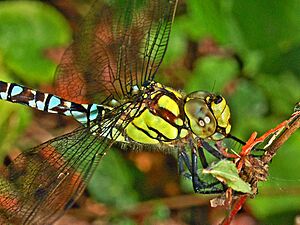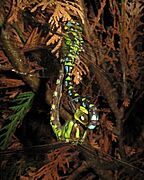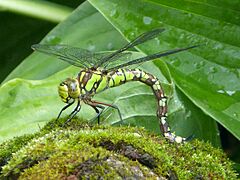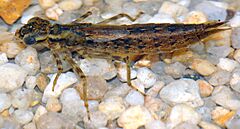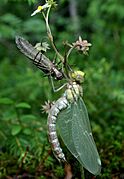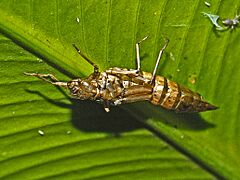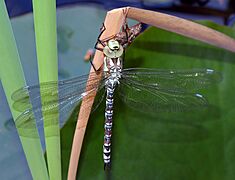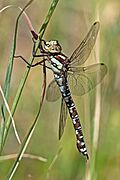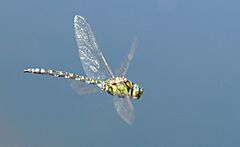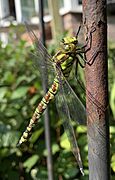Southern hawker facts for kids
Quick facts for kids Southern hawker |
|
|---|---|
 |
|
| Male, Germany | |
 |
|
| Female | |
| Conservation status | |
| Scientific classification | |
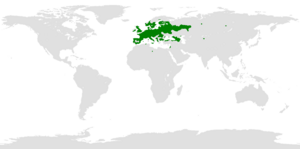 |
|
| Range of Aeshna cyanea | |
| Synonyms | |
The Southern Hawker (also called the Blue Hawker) is a type of large dragonfly. Its scientific name is Aeshna cyanea. It belongs to a group of dragonflies known as hawkers. These amazing insects are known for their bright colors and fast flight.
Contents
Where Southern Hawkers Live
The Southern Hawker is one of the most common dragonflies in Europe. You can find them across a large part of Europe, from Scotland and southern Scandinavia in the north, all the way down to Italy and the northern Balkans. They live as far east as the Urals mountains and as far west as Ireland. You can also spot them in northwest Africa, especially in Algeria. In the middle of Europe, they are very common.
Southern Hawker Homes
These dragonflies mostly live near small ponds and garden ponds that have lots of plants. But they also like to fly around a lot. You can often see them in gardens and open woodlands, far from water.
What Southern Hawkers Look Like
Southern Hawkers are big, colorful dragonflies. They can grow to be about 70 millimetres (2.8 in) long, which is almost 3 inches! Their wings can spread up to 110 millimetres (4.3 in) wide, about 4 inches.
Their body is long. The part behind their head, called the thorax, is brown. It has two wide, bright green stripes running down it. On their forehead, there's a black mark that looks like the letter "T". Their wings are clear, but they have a dark spot called a pterostigma near the tip. The front edge of their wings is also dark.
- Males: Have a dark body with bright apple-green markings. The last few parts of their body (segments S8-10) have pale blue markings that are connected. Their eyes are green at the bottom and fade to blue or greenish-blue at the top.
- Females: Have a brownish body with bright green markings all over. Their eyes are usually yellowish-green or brownish.
Southern Hawker Behavior
You can usually see adult Southern Hawkers flying from June to October. Sometimes, you might even spot them in May or November. These dragonflies are hunters! They catch and eat other insects while flying. They are also quite curious and might even fly close to people to check them out.
Life Cycle and Reproduction
Southern Hawkers lay their eggs in still or slow-moving water. The males often fly back and forth along the edges of ponds or rivers. They are very protective of their territory and will fight off other male dragonflies. They might even crash into rivals and spin through the air!
Females are usually harder to spot when they are laying eggs. They sometimes give away their hiding spot by flying up quickly from the reeds. They lay their eggs by poking their body into rotting plants or wood.
The eggs hatch in the spring, even if they were laid the summer or autumn before. The young dragonflies, called nymphs, live in the water. They eat other water insects, small tadpoles, tiny water creatures, and even small fish. They grow for two to three years before they are ready to become adults. They usually emerge from the water as adults in July and August.
Are Southern Hawkers Dangerous?
Even though Southern Hawkers are quite large and eat many insects, they are completely harmless to humans. People sometimes mistake the parts at the end of their body (called cerci) for claws or stingers. But dragonflies cannot sting or hurt humans.
Southern Hawkers, especially the males, are very active flyers. They are also quite curious. You might see them flying hundreds of meters away from water, in open fields, parks, hiking trails, or even busy streets. They sometimes fly close to people, but they usually stay a little distance away. They will not attack humans, unlike wasps or hornets that might sting if they feel threatened.
Life Cycle Gallery
See also
- List of British dragonflies



